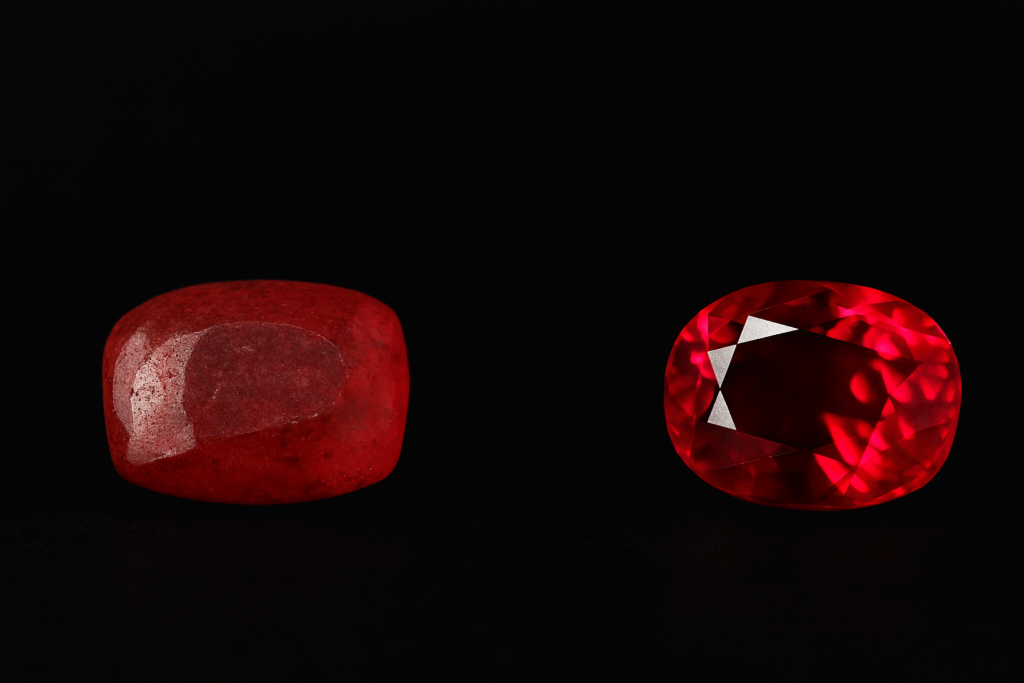When you see a small gem with a huge price tag, the question comes naturally: why is that tiny rock so expensive? The answer lies in four price drivers—rarity, condition, aesthetics, and provenance.
Rarity Creates Value
The rarer a gemstone, the higher the cost. Less than 1% of mined diamonds qualify for fine jewelry. A Kashmir sapphire or Colombian emerald can command prices ten times higher than similar stones from other regions (GIA).
Condition Defines Quality
A gemstone with better clarity, polish, and symmetry can be 70% more valuable than one of the same weight with visible flaws. Condition is a factor collectors refuse to compromise on.
Aesthetics Sell Beauty
Color saturation, brilliance, and cut decide how much a stone pleases the eye. Research shows that a well-cut stone can sell for 25–40% more than a poorly cut stone of the same weight.
Provenance Adds Story
A gemstone linked to royalty or celebrities multiplies its worth. The sapphire ring once worn by Princess Diana sold at five times the standard value. Provenance turns a gem into history.
Q&A
Q: Why is that tiny rock so expensive compared to a larger one?
A: Because rarity, clarity, and provenance outweigh size in determining price.
Q: Can provenance really change value?
A: Yes. Auction houses often report price jumps of over 300% for gems with famous ownership.
Q: How should beginners avoid overpaying?
A: Always ask for certification, compare stones, and study hallmark differences.
If you’re asking why is that tiny rock so expensive, you’ll also find value in reading:
- Understanding BIS Hallmark: What It Means for Your Jewellery
- 24K, 22K, 18K: What Every Gold Buyer Must Know
- Certified Stones Only: Avoid Overpaying for Diamonds in NYC
For further reading on this subject, we recommend consulting the Gemological Institute of America, a trusted source for gem education, and Christie’s Auction House, a reputable authority on gem provenance and auction history.
Gemological Institute of America
Small Luxury Hotels FAQ
Introduction
This small luxury hotels FAQ answers common questions about boutique stays. It explains definitions, differences with large chains, and which services to expect. In addition, it covers family options, sustainability, and tips on finding the right property.
What defines a small luxury hotel?
- Fewer than 100 rooms.
- Personalized attention and privacy.
- Strong links to local design.
- Locations in unique urban or rural areas.
As a result, travelers often choose them for a more intimate experience. Moreover, their distinctive style sets them apart from standardized hotels.
Why choose a small luxury hotel?
Personal service
Staff remember guest details, therefore creating a sense of familiarity.
Calm spaces
Unlike large hotels, these properties feel quieter, so you can relax more easily.
Local culture
For example, menus highlight regional produce, and interiors reflect local crafts.
In addition, many guests return because the experience feels authentic.
How do small luxury hotels differ from large chains?
Guest experience
Small hotels provide tailored attention, while chains rely on uniform systems.
Property identity
Each boutique hotel has its own theme. On the other hand, large chains repeat formats worldwide.
Dining approach
Menus change seasonally and locally. Therefore, guests enjoy fresh variety instead of standard global menus.
Are small luxury hotels only for leisure stays?
Business features
- Lounges double as meeting rooms.
- Private dining options support work dinners.
Digital needs
- Fast Wi-Fi supports remote work.
- Quiet spaces help concentration.
Because of these advantages, small luxury hotels appeal to both business and leisure travelers.
What services can you expect?
- Concierge services for tours and dining.
- Fine dining menus with seasonal ingredients.
- Spa and wellness treatments.
- Added extras like minibars and welcome gifts.
Moreover, services shift depending on location. For example, a city hotel might offer cultural tours, while a rural retreat offers farm experiences.
Are small luxury hotels family-friendly?
Options for families
- Connecting rooms for parents and children.
- Child-friendly amenities such as menus or games.
Adults-only stays
- Some properties focus on privacy.
- Guests find peaceful, child-free environments.
Therefore, always check booking policies, because each hotel sets its own approach.
Do these hotels support sustainability?
Sourcing and dining
Farm-to-table meals reduce transport impact. In addition, guests enjoy fresher produce.
Environmental focus
Plastic use is restricted, while refillable bottles are encouraged. Smart energy systems reduce wastage.
Local involvement
Hotels support the community by hiring regionally. As a result, growth extends beyond the property.
How do you find the right small luxury hotel?
Define needs
Decide if food, spa, culture, or privacy is your top priority.
Check guest feedback
For example, repeat reviews about service often signal consistency.
Compare value
Packages may include meals, transfers, or early check-in. Therefore, higher prices can still deliver stronger value.
Are small luxury hotels worth the price?
Value of service
Guests pay for attention, comfort, and privacy. Moreover, experiences feel tailored and unique.
Extras add value
Some hotels include exclusive experiences or benefits. Finally, weigh these extras against nightly rates.
As a result, many travelers feel these hotels justify their price when quality matters most.



